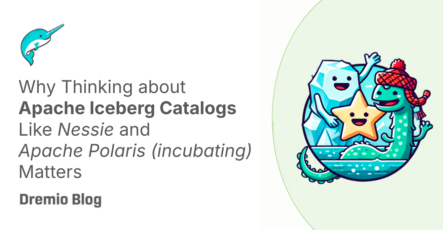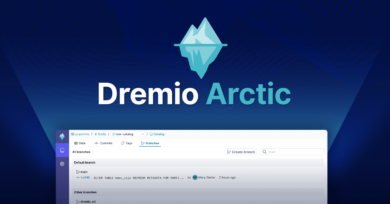9 minute read · September 5, 2024
Why Thinking about Apache Iceberg Catalogs Like Nessie and Apache Polaris (incubating) Matters
· Head of DevRel, Dremio

Learn more about Apache Polaris by downloading a free early release copy of Apache Polaris: The Definitive Guide along with learning about Dremio's Enterprise Catalog powered by Apache Polaris.
The Data Lakehouse pattern, which involves building data warehouse-like functionality on top of a data lake, is rapidly becoming a popular data architecture trend. This approach offers several benefits, including faster data delivery, the ability to make data accessible across teams regardless of their preferred query tools, and a reduction in compute and storage costs.
Apache Iceberg has emerged as a crucial component of the data lakehouse architecture, providing a consistent way to define Parquet-based datasets while offering data warehouse features such as ACID guarantees and table evolution. To ensure these tables are accessible across various tools, like Dremio and Apache Spark, you need a "Lakehouse Catalog"—a catalog that tracks lakehouse tables and ensures portability across different query engines. As Iceberg-based lakehouses become more widely adopted, the need for enterprise-ready catalogs is becoming a key focus.
Check out these articles to learn more about Iceberg and the evolving catalog landscape.
Data Lakehouse
Apache Iceberg
- Apache Iceberg 101
- Free Copy of "Apache Iceberg the Definitive Guide"
- Free Apache Iceberg Crash Course
Lakehouse Catalogs
- The Evolution of Iceberg Catalogs
- Dremio's Enterprise Lakehouse Catalog
- Introduction and Concepts around Apache Polaris (Incubating)
- Hands-on with Apache Polaris OSS
- Introduction to Nessie
- Hands-on with Dremio and Nessie on your Laptop
- What the Apache Iceberg REST Catalog is and isn't
5 Value Propositions of Lakehouse Catalogs
1. Portability of Tables
One of the key functions of catalogs in the Apache Iceberg ecosystem is to maintain a record of each table, mapped to the storage location of its current metadata.json file. This allows query engines to send requests to the catalog and identify the precise location of the Iceberg table's current metadata they need to query. Without this functionality, it would be challenging for query engines to determine which metadata.json file—whether it’s v1.metadata.json, v2.metadata.json, or something like 84029348203984.metadata.json—is the correct one for interpreting the table's structure and state consistently across engines.
Try Dremio’s Interactive Demo
Explore this interactive demo and see how Dremio's Intelligent Lakehouse enables Agentic AI
2. Enables Concurrency
Apache Iceberg catalogs also play a crucial role in enabling concurrency control within Iceberg. Catalogs like Nessie and Polaris utilize a backing store with locking mechanisms to ensure that only one update to a table's reference can occur at any given time. Additionally, during the update process, the writer checks the catalog for the latest metadata.json both before and after a transaction to verify the sequence number, ensuring that no other writes were completed before committing the transaction by updating the catalog reference. This mechanism is essential to maintaining Apache Iceberg's ACID guarantees.
3. Portable Governance
A more recent development in catalogs is their role as a store for access rules, allowing consistent permissions enforcement across various query engines. Nessie and Polaris support mechanisms to define access rules, enabling control over which users can access specific objects. When a user doesn’t have permission to access a particular table, such as TableX, the catalog responds to the engine’s metadata request for that table with an unauthorized error. This shifts governance to the catalog level, creating a centralized point for managing access rather than enforcing governance separately for each engine—assuming the engine even supports governance controls.
4. Catalog Versioning
An innovation introduced by Dremio's Nessie is the concept of "Catalog Versioning." While Apache Iceberg tables natively track versions at the table level, Nessie’s catalog versioning captures snapshots of the entire set of tables along with their metadata references. It also supports Git-style commits to this catalog listing, which can be branched like code in Git. This enables the isolation of changes across multiple tables, allowing for advanced features such as multi-table transactions, tagging, rollbacks, and the ability to create zero-copy environments for experimentation. As noted in this article, there is potential for this catalog versioning capability to be integrated into Apache Polaris (incubating) in the future.
5. Lakehouse Management
With managed deployments of open-source catalogs that offer additional quality-of-life features, these catalogs are evolving into "lakehouse management" platforms. For example, Dremio’s Integrated Lakehouse Catalog, deeply embedded into its lakehouse platform, provides a managed version of these open-source technologies, enhanced with features for governance, table optimization, clean-up, and catalog versioning—all within an enterprise-grade solution. This greatly simplifies the adoption of and migration to Iceberg. When you combine that with Dremio's flexibility to operate in both cloud and on-prem environments, and its ability to connect seamlessly with data lakes, data warehouses, and databases across cloud and on-prem, it becomes a powerful, unified analytics offering.
Conclusion
Iceberg catalogs are essential in the Iceberg lakehouse ecosystem, enabling core features such as table portability, concurrency control, governance, and versioning. As data lakehouse adoption grows, solutions like Nessie, and Apache Polaris (incubating) provide the necessary tools to streamline data management across diverse environments. With innovations like catalog versioning and centralized governance, these catalogs ensure consistency and reliability and empower organizations to manage their data more efficiently.
Furthermore, managed deployments of catalogs, such as Dremio's Integrated Lakehouse Catalog, are transforming these technologies into comprehensive lakehouse management platforms. By simplifying Iceberg adoption and offering enterprise-grade capabilities, these platforms enable businesses to unify their analytics and optimize their data infrastructure, both in the cloud and on-premises.
As the landscape evolves, staying informed about the advancements in lakehouse catalogs will be crucial for organizations looking to build scalable, efficient, and future-proof data architectures.


